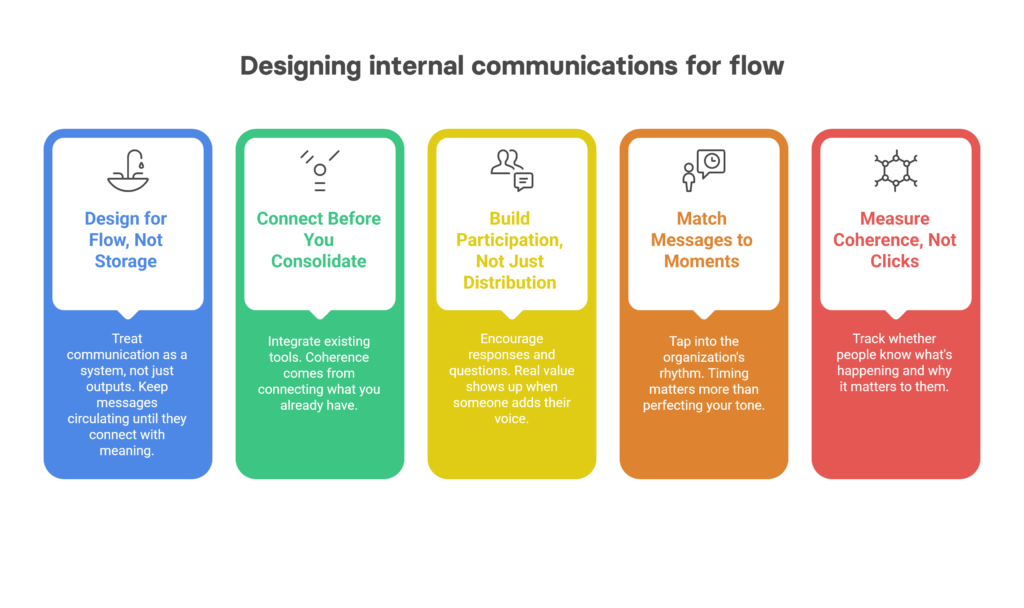Every organization today looks connected.
Messages move at breakneck speed, communication channels keep multiplying and everyone’s got access to platforms where their voice can be heard. On the surface, it all seems pretty functional. But if you spend any time actually working in these environments, you start noticing something else. The clarity just isn’t there.
The data backs this up in a pretty sobering way. Gallup research shows only 13% of employees think their company’s communication is excellent. Thirteen percent! And Deloitte’s 2024 Human Capital Trends report found that even though employees are getting more messages from their organizations than ever before, most of them still can’t tell you what the company’s actual priorities are.
So you’ve got this weird situation where there’s tons of communication happening but very little of it is creating understanding.
Internal comms teams aren’t sitting around doing nothing. Most are buried under the weight of content calendars, new platform rollouts and an endless stream of updates to push out. The work is happening. But somewhere along the way, we lost the structure that makes all this effort actually effective. The invisible scaffolding that determines whether a message reaches people in a way that makes sense or just gets lost in the shuffle.
We’ve scaled communication rapidly without bothering to upgrade the foundations. The systems that worked when everyone was in the same building just don’t function in a world of distributed teams, constantly divided attention and org structures that seem to shift every quarter.
It’s less about how often we communicate and more about whether the underlying system can actually handle what we’re asking it to do. Because connection doesn’t just happen. It’s built. And right now, what we’ve built isn’t working.
How we ended up with too many tools
The story of modern internal communication starts in a much simpler time.
When intranets showed up, they felt like a revelation. Here was a digital home for everything employees needed to know. One space, one structure, one version of the truth. Updates at the top, resources in the middle, policies down at the bottom. Hierarchical and tidy, sure, but also reassuringly predictable.
That design made complete sense back then. Organizations were mostly centralized, people worked from offices and information needed to be controlled rather than constantly flowing. The intranet wasn’t trying to inspire anyone or spark conversations. Its job was to manage risk and maintain order. For a while, that kind of top-down clarity actually worked.
But work started changing and those tidy systems couldn’t keep up.
Hybrid work became normal. Everyone had a mobile device in their pocket. Projects required constant cross-functional collaboration instead of staying neatly within departments. Communication stopped being this periodic, formal thing and became constant, conversational, urgent. A system built to store information can’t handle that kind of movement.
So what happened? Companies added more tools.
Each new platform promised to be the answer. Faster communication, better collaboration, more engagement. But here’s the thing: nothing replaced what came before. It all just stacked up. Now you’ve got the intranet still sitting there, plus email, plus Slack/Teams, plus SharePoint, plus Yammer. Each one does something useful on its own. Together, they create chaos.
Messages travel everywhere without actually going anywhere specific. Employees scroll through channels trying to figure out where they saw that thing from last week. Teams post the same announcement in five places because they’re not sure where people will actually look. We built all these ways to connect and somehow it got harder to stay aligned.
This is where we’ve ended up: communication happening constantly but coherence? That’s gone missing.
Which is why things are finally shifting. Not just toward better channels for distributing information but toward actual ecosystems that can organize it in ways that make sense.
Communication as a living network
Something’s been shifting inside organizations over the past few years and it’s easy to miss if you’re not looking closely.
Communication doesn’t live in neat channels anymore. It’s not sitting in weekly newsletters or company updates posted at the top of an intranet. It moves everywhere, in every direction, shaped by whoever has something to say. The idea of a single “home” for internal messages doesn’t really apply. What we’re building now looks more like a living network than a central hub.
And this isn’t just about new technology. It’s behavioural.
People expect information instantly. They want it conversational, personalized, responsive. Hybrid work blurred the line between formal announcements and actual dialogue, so now leadership updates sit right next to project threads. Ideas surface from comment sections. Employees walk into work expecting the same immediacy they get from every other app on their phone and they don’t see why the company should be any different.
The old model was built around control. Information got stored in one place, messages flowed from the top down and communication moved in predictable patterns. That’s all gone. What replaced it is dynamic and participatory. Connections get designed instead of dictated. Meaning gets created through interaction rather than handed down fully formed.
Communication now behaves less like a channel and more like an actual system. It grows, it responds, it connects people with content and context as things unfold. When it works, it makes the organization feel smaller and more human even as the company expands.
That’s what’s actually changing here. Internal communication stopped being about distributing messages. Now it’s about designing flow, making sure what gets said and seen and shared travels the right way through the organization and lands where it matters.
If communication behaves like an ecosystem now, it needs architecture that can sustain it.
So what does that architecture actually look like?
The anatomy of the new architecture
Across different organizations, a new kind of structure is quietly taking shape. What’s emerging isn’t just another tool but a different logic underneath how communication actually works.
Most teams don’t sit down and formally design this. It emerges when they’re trying to make sense of everything that’s already happening, all the messages and platforms and conversations piling up. Over time, patterns start to surface. What you find at the centre are three layers that work together, each doing something different but needing the others to function.

Content (clarity)
Information has to live somewhere. Updates, news, resources that keep everyone informed. But clarity goes beyond just hitting publish. You need to make sense of what you’re putting out there. When content gets organized around what people actually need to know instead of who happens to be posting it, things start clicking. Employees can figure out what matters without drowning in everything else.
Chat & Comments (participation)
This is where meaning actually gets built. Dialogue, reactions, the casual back-and-forth that gives messages real context. It turns information into interaction. Leadership updates meet comments and questions. Ideas bubble up. Those everyday moments of shared understanding happen here. For most organizations, this layer is what makes the whole thing feel alive instead of mechanical.
Feedback (alignment)
The part that closes the loop. Surveys, polls, engagement data that help teams figure out if messages are actually landing. Listening becomes built into the structure instead of something you remember to do occasionally. When people see their input changing what happens next, communication stops feeling like a one-way broadcast and starts feeling reciprocal.
These layers don’t work in isolation. Clarity sparks participation. Participation surfaces feedback. Feedback refines clarity. When that loop keeps moving, communication becomes more than just a collection of messages. It turns into an operating system running beneath everything else.
You could think of it as a communication OS. Invisible when it works, essential for keeping information, dialogue and insight moving in sync. The real shift happens when you understand how these layers connect, because once they do, the system starts sustaining itself.
Designing for flow
Most communication challenges have nothing to do with effort. Messages get made, approved and sent out. But somewhere between “publish” and “read,” the current just dies. Designing for flow means building pathways that keep things moving. Less of a process change, more of a shift in how you think.
Once you start seeing communication as a system rather than a series of outputs, certain principles become obvious.

Design for flow, not storage
The easiest mistake is treating communication like something that needs to sit somewhere. A post on the intranet. An update in the newsletter. But storing information doesn’t create understanding. Movement does. Keep messages circulating until they actually connect with meaning.
Connect before you consolidate
Teams waste months hunting for the “one perfect platform” that’ll solve everything. But coherence doesn’t usually come from ripping everything out and starting over. It comes from connecting what you already have. Integration between tools, single sign-on, shared data layers. That’s what makes communication feel unified even when it’s happening across different platforms.
Build participation, not just distribution
Publishing a message is only half the job. The other half happens when people respond, question it, build on it. Real value shows up in the return, that moment when someone else adds their voice to the mix.
Match messages to moments
Every organization has a rhythm. Onboarding periods, product launches, quarterly cycles, big change announcements. The most effective communication taps into that existing rhythm instead of fighting it. Getting the timing right matters more than perfecting your tone.
Measure coherence, not clicks
Sure, numbers matter. But tracking the wrong ones just gives you false confidence. High open rates don’t guarantee anyone understood what you said. Thousands of likes don’t mean you achieved clarity. The metric that actually matters? Whether people know what’s happening and why it matters to them.
These aren’t rigid steps to check off. They’re ways of thinking about how information actually moves through people, not just systems. Get the flow right and something interesting happens. You stop chasing engagement because it starts showing up on its own.
How AOK built alignment
At some point, every idea has to work under real-world conditions.
For AOK, one of Germany’s largest statutory health insurers, that test came when traditional channels couldn’t keep up with how people actually communicated anymore. The scale here is massive. Eleven independent regional health insurance funds, more than 61,000 employees, around 27 million insured citizens. Each regional fund runs autonomously, managing its own teams and workflows.
For years, internal communication ran on printed magazines and local intranets. Worked fine when everyone sat in offices. Stopped working when employees went mobile and distributed.
The pandemic made that gap impossible to ignore.
AOK needed to reach every employee consistently and securely, without losing the ability for each region to manage its own voice. Together with KomPart, they introduced a shared digital platform powered by tchop™. Each regional fund launched its own version of the app, tailored to local needs but built on one connected infrastructure. Some used it as a front-door intranet, others as a social or news app. Different purposes, same foundation.
The logic behind it was simple but powerful.
- Content provided structure and clarity through curated updates, videos and internal stories.
- Participation through comments, reactions and direct interaction.
- Feedback closed the loop via polls and analytics that helped editors understand what actually resonated.
For the first time, AOK could reach every employee through a single system. Desk workers, field teams, everyone. Same consistency, same rhythm. Editors gained insight into what mattered most. Leadership finally had a direct line to people across all eleven regions.
What makes this story worth paying attention to has nothing to do with the specific technology. What matters is the structure behind it. Communication became scalable once they treated it as architecture instead of output, designed to flow through the organization rather than sit beside it.
That’s what the future of connection actually looks like. Systems that hold conversation, not just content.

The communicator as systems designer
Somewhere between endless updates and actual conversations, internal comms stopped being about delivery. Now it’s about design. Not the visual design of a message but how meaning travels through a company.
Architects don’t start with content. They start with structure. The same shift is happening here.
The work used to be “what do we say this week?” These days it’s more like “how does information actually move around here? Who shapes it along the way? Where does it collect into something people can use?” Look at the role through that lens and different skills start mattering.
Systems thinking. You need to see the paths, not just the posts. Map how content, dialogue and feedback interact so the whole thing keeps working even when pressure mounts.
Empathy as practice. Design for how people actually work. Their scattered moments, their constraints, the seventeen things competing for their attention right now. Less about tone, more about basic usability.
Data literacy. Not dashboards you build to look busy. Real signal detection. Can people tell you what’s happening? Do they know why it matters? Are they confident about what comes next?
This shift feels healthy to me. It pulls the discipline closer to the business it serves. Clarity helps people make decisions. Participation builds trust. Feedback adjusts course before small friction turns into major resistance. Treat communication as structure instead of decoration and it stops being noise. Starts becoming culture.
This isn’t about getting a bigger megaphone. Better architecture, that’s what matters. Quietly, that’s what separates teams who broadcast from teams who actually connect. The best internal communicators feel less like campaign owners these days. More like stewards of flow.
Intranets managed information. Ecosystems manage relationships.
If you need an operating layer that holds content, chat and feedback together without demanding constant attention, tchop™ handles that work in the background. The point here is the coherence, not the tool. Test drive tchop with a fully branded free employee app for your organisation.







